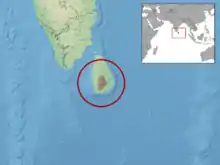Lankascincus taprobanensis
Lankascincus taprobanensis, also known commonly as the Ceylon tree skink and the smooth Lanka skink, is a species of lizard in the family Scincidae. The species is endemic to the island of Sri Lanka.[1][3]
| Lankascincus taprobanensis | |
|---|---|
| Scientific classification | |
| Domain: | Eukaryota |
| Kingdom: | Animalia |
| Phylum: | Chordata |
| Class: | Reptilia |
| Order: | Squamata |
| Family: | Scincidae |
| Genus: | Lankascincus |
| Species: | L. taprobanensis |
| Binomial name | |
| Lankascincus taprobanensis | |
 | |
| Synonyms[3] | |
Habitat and distribution
The smooth Lanka skink is found from 1,000 to 2,300 metres (3,300 to 7,500 ft) above sea level, and is the only skink found at the 2,300-metre (7,500 ft) elevation in Sri Lanka. It is common in the Horton Plains, Hakgala, Namunukula, and Nuwara Eliya.[4]
Description
The body of L. taprobanensis is stout, and the length of the tail is 1.3 to 1.5 times that of the body. The fronto-parietals are distinct. The parietals are in narrow contact. There are 24 to 27 rows of scales at midbody. There are 9 to 17 lamellae under the fourth toe. The dorsum is gray, reddish brown, brownish yellow, or olive-colored. Each scale has a median dark spot. There is a brownish black lateral stripe with yellowish cream flecks running from the eye to the base of the tail. The venter is lemon yellow. The throat is pale blue with a few scattered dark spots. The Iris is very dark brown-colored.
Ecology and diet
The diet of the Ceylon tree skink includes insects.[1]
Reproduction
An adult female of L. taprobanensis may lay one to two eggs, each measuring 7 by 12.5 millimetres (0.28 by 0.49 in), per clutch in loose soil. Hatchlings measure 19 millimetres (0.75 in).
References
- Ukuwela, K.; Kannishka [sic], S.; Karunarathna, S. (2021). "Lankascincus taprobanensis ". IUCN Red List of Threatened Species. 2021: e.T157795984A123308872. Retrieved 20 November 2021.
- "Lankascincus taprobanensis Kelaart, 1854". Global Biodiversity Information Facility. November 3, 2014. Retrieved April 3, 2015.
- "Lankascincus taprobanensis ". The Reptile Database. Retrieved April 3, 2015.
- "Endemic Scincid Lizards of Sri Lanka". Endemic Animals of Sri Lanka. 2011. Retrieved April 3, 2015.
Further reading
- Boulenger GA (1887). Catalogue of the Lizards in the British Museum (Natural History). Second Edition. Volume III. ... Scincidæ .... London: Trustees of the British Museum (Natural History). (Taylor and Francis, printers). xii + 575 pp. + Plates I–XL. (Lygosoma taprobanense, pp. 319–320).
- Kelaart [EF] (1854). "Descriptions of new species of Ceylon Reptiles". Annals and Magazine of Natural History, Second Series 13: 407–408. (Eumeces taprobanensis, new species, p. 407).
- Somaweera R, Somaweera N (2009). Lizards of Sri Lanka, A Colour Guide with Field Keys. Frankfurt am Main, Germany: Edition Chimaira / Serpents Tale. 304 pp. ISBN 978-3899734782.
